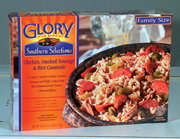
Deep South cooking sets itself apart from its other Southern cousins, as the dishes are usually well-seasoned and yield lots of flavor. Fried green tomatoes, greens, fried catfish, corn bread, fried corn, and sweet potato pie are mainstream Southern dishes that can be found at any Southern-influenced restaurant.
Diverse Southern Cuisines
There are many Southern recipes and food products produced and accepted as mainstream foods that are eaten across the country. While many consider the South one uniform area, Southern regional foods are as diverse as the people who live there. Low Country, Gullah, Cajun, Creole, and Deep South cooking all have played a major role in giving birth to what is considered today's Southern cooking.Low Country cooking started in South Carolina, along the Carolina coastal plain, where seafood is plentiful. As a result, many Low Country dishes feature rice and seafood as a base. Signature dishes include shrimp & grits, she-crab soup and Hoppin' John, which is a one-meal dish containing black-eyed peas, rice and smoked pork.
Former slaves who migrated from the mainland to the sea islands off the coasts of South Carolina and Georgia were responsible for the beginnings of Gullah cooking. This cooking technique and language can be traced back to the countries of Western Africa. Gullah rice (also known as Jollof rice), peanut soup (sometimes called groundnut or goober nuts), and okra stews are signature foods. Over the years, much of the land that makes up the sea islands has been replaced with luxury golf resorts and vacation homes, as has happened in the Hilton Head area, but the culinary influences remain strong today.
One of the South's better-known cuisines, Cajun, was created by the French Acadians who migrated from Canada to the swamps, bayous and backwoods of Southern Louisiana. Restaurant owner/food manufacturer, Paul Prudhomme, and the late PBS TV cook host, Justin Wilson, introduced Cajun foods to Americans who lived outside of Louisiana, and made them famous. Cajun cooking is hearty, with big portions, and true to country cooking style. Dirty rice, blackened fish, red beans and rice, and Cajun barbecue shrimp are popular dishes.
Creole foods combine the elements of French, Spanish, and African food ingredients with the cooking techniques found in those countries. It is an elegant and sophisticated cuisine—a style of cooking that was derived from the aristocrats and landowners in Louisiana, who originally migrated from Europe.
Jambalaya, a seafood and rice dish that is heavily influenced by the Spanish paella, is a popular Creole dish. Gumbo, shrimp Creole, and beignets are other examples of typical Creole cooking.

Companies Create Deep South Flavors
Glory Foods, Columbus, Ohio, produces an extensive line of Southern-style canned vegetables, including collard greens, kale greens, mixed greens, mustard greens, turnip greens, black-eyed peas, butter beans, okra and sweet potatoes. Several of these vegetables are grown by a cooperative of black farmers in the Mississippi Delta region. The purpose of the partnership is to provide a support network for small farms owned by African-American farmers who have been squeezed out of vegetable production in larger markets, and to promote their businesses.
Located in the Southern Appalachian Mountains of North Carolina, Forge Mountain Country Foods uses the slogan: “We take you back to grandma's kitchen every time you open a jar.” Forge Mountain Country Foods produces down-home flavored condiments such as chow-chow, pickled okra, tomato preserves, and muscadine mountain jelly. This 35-year-old company manufactures its products in small batches with the freshest ingredients available to ensure the finest quality.
For the Sweet Tooth
Bread Puddin' Crunch Inc., Chicago, produces a savory bread pudding dessert. “It is the 'C' for comfort,” says Gwen Meek, president. “Our product is called bread puddin' crunch because of the special processing technique that it undergoes.” Like other bread puddings, this one is made from stale bread. However, this product can be stored in the freezer for up to three months, depending on the recipe/formula. Once thawed, it can be eaten at room temperature or heated up.
Resources:
Forge Mountain Foods at 800-823-6743
Bread Puddin Crunch, Inc. at 773-375-5100